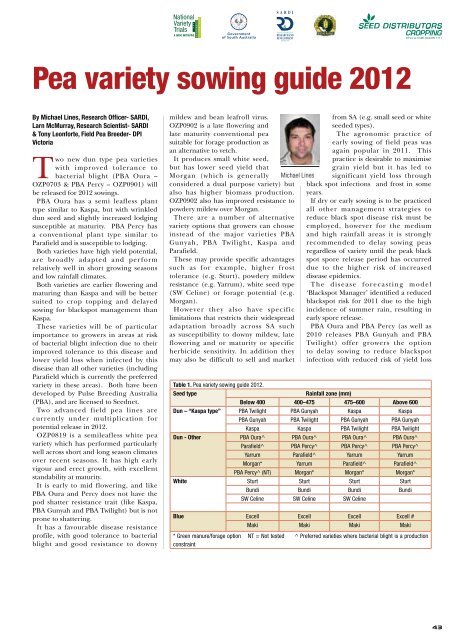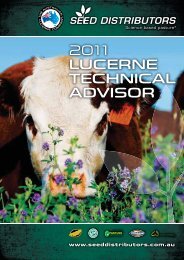Lentil variety sowing guide 2012 - Seed Distributors
Lentil variety sowing guide 2012 - Seed Distributors
Lentil variety sowing guide 2012 - Seed Distributors
Create successful ePaper yourself
Turn your PDF publications into a flip-book with our unique Google optimized e-Paper software.
Pea <strong>variety</strong> <strong>sowing</strong> <strong>guide</strong> <strong>2012</strong><br />
By Michael Lines, Research Officer- SARDI,<br />
Larn McMurray, Research Scientist- SARDI<br />
& Tony Leonforte, Field Pea Breeder- DPI<br />
Victoria<br />
Two new dun type pea varieties<br />
with improved tolerance to<br />
bacterial blight (PBA Oura –<br />
OZP0703 & PBA Percy – OZP0901) will<br />
be released for <strong>2012</strong> <strong>sowing</strong>s.<br />
PBA Oura has a semi leafless plant<br />
type similar to Kaspa, but with wrinkled<br />
dun seed and slightly increased lodging<br />
susceptible at maturity. PBA Percy has<br />
a conventional plant type similar to<br />
Parafield and is susceptible to lodging.<br />
Both varieties have high yield potential,<br />
are broadly adapted and perform<br />
relatively well in short growing seasons<br />
and low rainfall climates.<br />
Both varieties are earlier flowering and<br />
maturing than Kaspa and will be better<br />
suited to crop topping and delayed<br />
<strong>sowing</strong> for blackspot management than<br />
Kaspa.<br />
These varieties will be of particular<br />
importance to growers in areas at risk<br />
of bacterial blight infection due to their<br />
improved tolerance to this disease and<br />
lower yield loss when infected by this<br />
disease than all other varieties (including<br />
Parafield which is currently the preferred<br />
<strong>variety</strong> in these areas). Both have been<br />
developed by Pulse Breeding Australia<br />
(PBA), and are licensed to <strong>Seed</strong>net.<br />
Two advanced field pea lines are<br />
currently under multiplication for<br />
potential release in <strong>2012</strong>.<br />
OZP0819 is a semileafless white pea<br />
<strong>variety</strong> which has performed particularly<br />
well across short and long season climates<br />
over recent seasons. It has high early<br />
vigour and erect growth, with excellent<br />
standability at maturity.<br />
It is early to mid flowering, and like<br />
PBA Oura and Percy does not have the<br />
pod shatter resistance trait (like Kaspa,<br />
PBA Gunyah and PBA Twilight) but is not<br />
prone to shattering.<br />
It has a favourable disease resistance<br />
profile, with good tolerance to bacterial<br />
blight and good resistance to downy<br />
mildew and bean leafroll virus.<br />
OZP0902 is a late flowering and<br />
late maturity conventional pea<br />
suitable for forage production as<br />
an alternative to vetch.<br />
It produces small white seed,<br />
but has lower seed yield that<br />
Morgan (which is generally<br />
considered a dual purpose <strong>variety</strong>) but<br />
also has higher biomass production.<br />
OZP0902 also has improved resistance to<br />
powdery mildew over Morgan.<br />
There are a number of alternative<br />
<strong>variety</strong> options that growers can choose<br />
instead of the major varieties PBA<br />
Gunyah, PBA Twilight, Kaspa and<br />
Parafield.<br />
These may provide specific advantages<br />
such as for example, higher frost<br />
tolerance (e.g. Sturt), powdery mildew<br />
resistance (e.g. Yarrum), white seed type<br />
(SW Celine) or forage potential (e.g.<br />
Morgan).<br />
However they also have specific<br />
limitations that restricts their widespread<br />
adaptation broadly across SA such<br />
as susceptibility to downy mildew, late<br />
flowering and or maturity or specific<br />
herbicide sensitivity. In addition they<br />
may also be difficult to sell and market<br />
Michael Lines<br />
from SA (e.g. small seed or white<br />
seeded types).<br />
The agronomic practice of<br />
early <strong>sowing</strong> of field peas was<br />
again popular in 2011. This<br />
practice is desirable to maximise<br />
grain yield but it has led to<br />
significant yield loss through<br />
black spot infections and frost in some<br />
years.<br />
If dry or early <strong>sowing</strong> is to be practiced<br />
all other management strategies to<br />
reduce black spot disease risk must be<br />
employed, however for the medium<br />
and high rainfall areas it is strongly<br />
recommended to delay <strong>sowing</strong> peas<br />
regardless of <strong>variety</strong> until the peak black<br />
spot spore release period has occurred<br />
due to the higher risk of increased<br />
disease epidemics.<br />
The disease forecasting model<br />
‘Blackspot Manager’ identified a reduced<br />
blackspot risk for 2011 due to the high<br />
incidence of summer rain, resulting in<br />
early spore release.<br />
PBA Oura and PBA Percy (as well as<br />
2010 releases PBA Gunyah and PBA<br />
Twilight) offer growers the option<br />
to delay <strong>sowing</strong> to reduce blackspot<br />
infection with reduced risk of yield loss<br />
Table 1. Pea <strong>variety</strong> <strong>sowing</strong> <strong>guide</strong> <strong>2012</strong>.<br />
<strong>Seed</strong> type Rainfall zone (mm)<br />
Below 400 400–475 475–600 Above 600<br />
Dun – “Kaspa type” PBA Twilight PBA Gunyah Kaspa Kaspa<br />
PBA Gunyah PBA Twilight PBA Gunyah PBA Gunyah<br />
Kaspa Kaspa PBA Twilight PBA Twilight<br />
Dun - Other PBA Oura^ PBA Oura^ PBA Oura^ PBA Oura^<br />
Parafield^ PBA Percy^ PBA Percy^ PBA Percy^<br />
Yarrum Parafield^ Yarrum Yarrum<br />
Morgan* Yarrum Parafield^ Parafield^<br />
PBA Percy^ (NT) Morgan* Morgan* Morgan*<br />
White Sturt Sturt Sturt Sturt<br />
Bundi Bundi Bundi Bundi<br />
SW Celine SW Celine SW Celine<br />
Blue Excell Excell Excell Excell #<br />
Maki Maki Maki Maki<br />
* Green manure/forage option NT = Not tested ^ Preferred varieties where bacterial blight is a production<br />
constraint<br />
43




